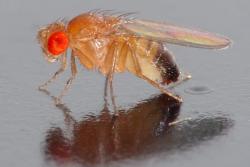Insect used as scientific âmodelâ has standardised names for body part names added
 A classic image of Drosophila melanogaster by André Karwath Surprisingly for a model organism which has been used in research that has led to the award of six Nobel Prizes for physiology and medicine, the humble or not so humble fruit fly, does not have a complete anatomical naming system.
A classic image of Drosophila melanogaster by André Karwath Surprisingly for a model organism which has been used in research that has led to the award of six Nobel Prizes for physiology and medicine, the humble or not so humble fruit fly, does not have a complete anatomical naming system.
The fruit fly has been widely used as a model organism to study genetics, neuroscience, physiology, development and immunity since the first decade of the 20th Century (1910) because of its relatively simple genetics and a rapid life cycle.
It was only in 2014 that all of its brain parts were given standardised names.
Now an international team led by Prof David Shepherd at Âé¶ṗṀḋÃẄẁßÇåḞæâs School of Natural Sciences has got to grips with the tricky process of disentangling and naming another vital part of the fruit flyâs anatomy, the ventral nervous system.
The results of that work are now published in Neuron (Court et al., A Systematic Nomenclature for the Drosophila Ventral Nerve Cord, Neuron (2020), https://doi.org/10.1016/j.neuron.2020.08.005).
The ventral nerve cord which runs through the insectâs thorax and abdomen can be compared to our own spinal cord and carries much of the same nerve information vital for movement such as walking and flying.
Not just a conduit of information, it also plays an active and important role in behaviour, sending information to the brain ensuring that behaviours are correctly executed.
As Prof David Shepherd explained:
âTo better understand something so complex and share the development of that understanding it is vital that we have a shared naming system for different regions of the nervous system,â
The first descriptions the ventral nerve cord were made as early as 1948, but over time the use and creation of names for regions has been inconsistent, which leads to confusion. We have also seen a huge explosion in the available tools to analyse the fruit flyâs anatomy and we now have an unprecedented body of information relating to this part of the brain.â
The work has taken over seven years, the group first having to identify and define the boundaries of different regions and structures.
âThen came the really difficult part, agreeing what to call each region and structure. For some structures this meant choosing the most commonly used names, where more than one had been used, and in other cases creating new names for structures for which no name existed. With boundaries and names agreed then came the task of establishing a text based definition,â adds Prof Shepherd.
Dr Darren W Williams from the Centre for Developmental Neurobiology, King's College London commented:
âWhilst this might seem a very curious task, in the absence of precisely named and defined structures it can be very hard to integrate the findings of different research projects. The creation of this naming system represents a major advance in the continued use of the fruit fly as a powerful experimental model.â
Publication date: 15 September 2020
